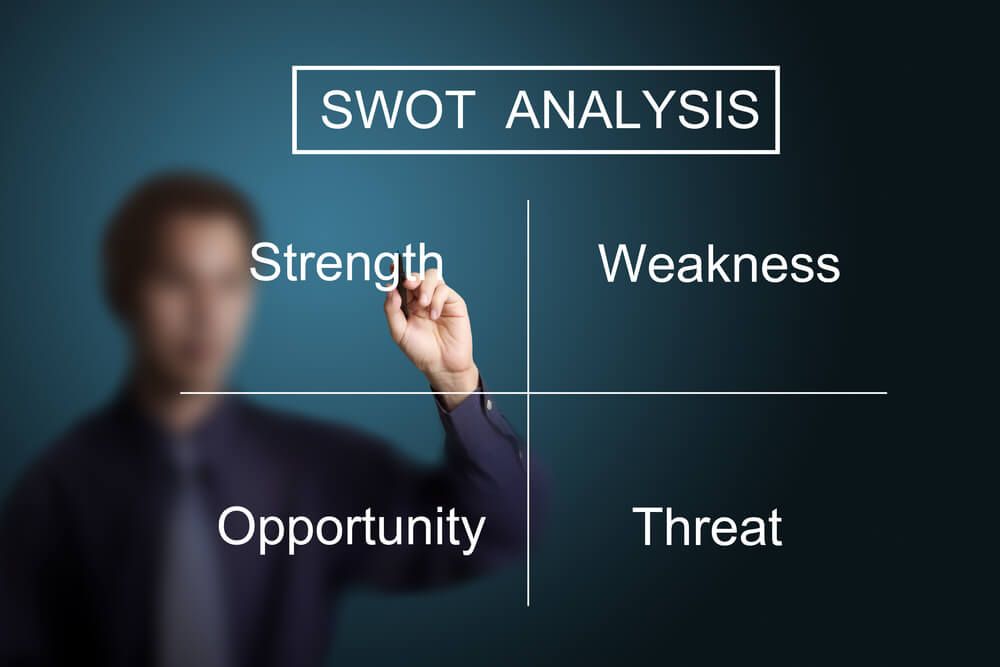
How SWOT Analysis Can Boost Your Marketing Strategy
A thorough digital marketing services agency analyzes many aspects of your business. These include your strengths, weaknesses, opportunities, and threats (SWOT) to assess your internal capabilities and external market conditions.
This article discusses the benefits of SWOT analysis, including the following:
- Identifying strengths for competitive advantage.
- Addressing weaknesses in marketing plans.
- Capitalizing on market opportunities.
- Mitigating external threats.
Read below to learn about SWOT analysis and how to integrate it into marketing strategies. Let’s go!
Are you looking for a full-service digital marketing agency? See the DAP difference below!
1. Identifying Strengths for Competitive Advantage
SWOT analysis involves identifying marketing strengths. It studies the following:
- Internal capabilities
- Resources
- Unique selling propositions
- Brand reputation
- Product quality
- Innovative technologies
- Talent
Marketing communications can then highlight these strengths to differentiate the brand, build credibility, and attract customers.
The following are examples of common marketing strengths and how to use them to grow and scale the business:
Strong Brand Reputation
A company wanting a solid brand reputation emphasizes trustworthiness, reliability, and quality in marketing communications. For example, highlighting customer testimonials or industry awards reinforces the brand’s credibility and attracts new customers who value reputable companies.
Unique Product Features or Innovation
Businesses with unique product features or innovative solutions differentiate themselves from competitors by showcasing these strengths in marketing campaigns. Product demonstrations, case studies, or comparison charts effectively illustrate the benefits of the company’s offerings, attracting customers seeking cutting-edge solutions.
Extensive Distribution Channels
Companies with extensive distribution networks or partnerships leverage this strength by ensuring the widespread availability and accessibility of their products or services. Omnichannel marketing strategies and partnerships with retailers or ecommerce platforms make it easier for customers to purchase products through their preferred channels.
Talented Marketing Team
A company with a talented marketing team leverages this strength by creating compelling and creative campaigns that resonate with target audiences. Content creation, social media management, and digital advertising help businesses engage with customers, drive brand awareness, and generate leads or sales.
High Customer Satisfaction and Loyalty
Businesses with high customer satisfaction and loyalty cultivate relationships with existing customers and encourage repeat business through loyalty programs, referral incentives, or personalized communication. Testimonials and exclusive offers emphasize the value proposition and encourage word-of-mouth referrals.
By aligning marketing strategies with their strengths, businesses position themselves effectively in the market, capitalize on their unique attributes, and gain a competitive edge over rivals.
2. Addressing Weaknesses in Marketing Plans

SWOT analysis improves different marketing plan elements by identifying internal weaknesses and challenges. Examples include limited brand awareness, poor product differentiation, or inefficient distribution channels.
Once identified, businesses can develop strategies to mitigate these shortcomings, such as investing in branding efforts, enhancing product features, or optimizing logistics or the supply chain.
The following are tips on addressing and mitigating weaknesses to improve marketing performance:
- Address weaknesses related to skills or knowledge gaps by providing employee training and development opportunities.
- Mitigate resource limitations by forming strategic partnerships or outsourcing specific tasks.
- Prioritize continuous improvement and innovation to manage product-related weaknesses.
- Solicit customer feedback, monitor industry trends, and invest in research and development to enhance product features, quality, or functionality, ensuring that offerings remain competitive and relevant.
- Mitigate weaknesses in operational inefficiencies or bottlenecks by conducting process audits and streamlining the workflow.
- Address weaknesses in customer satisfaction or retention by adopting a customer-centric approach. Gather customer feedback, identify pain points or areas for improvement, and implement strategies to enhance the customer experience, such as using automation.
Addressing weaknesses strengthens marketing plans, mitigates risks, and maximizes growth opportunities.
3. Capitalizing on Market Opportunities
Studying trends, consumer behavior, and emerging technologies lets businesses capitalize on market opportunities. They can anticipate shifts in demand, preferences, and purchasing habits and use the insights to adapt their strategies and offerings to meet evolving customer needs.
Additionally, emerging technologies allow companies to innovate, differentiate, and stay ahead of competitors. These cutting-edge solutions improve operational efficiency and position the business as an industry leader.
Consider these techniques to seize external opportunities to enhance marketing efforts:
- Conduct thorough market research and analysis to identify emerging trends, market gaps, and untapped opportunities.
- Stay informed about industry developments, innovations, and technological advancements relevant to your market.
- Gather customer feedback through surveys, focus groups, or social media to understand their changing needs, preferences, and pain points.
- Explore partnership opportunities with complementary businesses, influencers, or organizations to leverage their expertise, reach, or resources.
- Maintain adaptability and flexibility in marketing strategies to seize unexpected opportunities.
Ultimately, staying attuned to market dynamics and embracing opportunities presented by trends, consumer behavior shifts, and technological advancements enables businesses to seize competitive advantages and drive growth despite changing market conditions.
4. Mitigating External Threats

SWOT analysis mitigates external threats by identifying potential business risks and vulnerabilities. Examples are intense competition, changing market trends, or regulatory changes.
The information helps businesses develop strategies to manage these threats, such as diversifying product offerings or strengthening competitive positioning. Other tactics include the following:
- Conduct a comprehensive risk assessment to identify potential business threats and vulnerabilities.
- Develop contingency plans based on various potential scenarios or outcomes identified during the risk assessment.
- Establish clear protocols and procedures outlining how the business responds to threats or emergencies.
- Allocate resources and invest in preparedness measures to mitigate identified risks and enhance resilience.
- Continuously monitor and review contingency plans to ensure they remain relevant and effective.
- Regularly update plans based on new insights, changes in the business environment, or lessons learned from past incidents to maintain readiness and adaptability.
Integrating SWOT into Marketing Strategy Development
SWOT analysis aligns marketing efforts with business objectives. Companies can identify internal strengths and weaknesses and external opportunities and threats that might affect campaign outcomes.
This alignment also helps businesses leverage their strengths and opportunities to manage their weaknesses and mitigate external threats.
Here are the best practices for integrating SWOT into marketing campaigns:
- Develop marketing strategies that capitalize on identified strengths to differentiate the brand.
- Address weaknesses by implementing strategies to overcome them, such as contingency plans.
- Identify and prioritize opportunities identified in the SWOT analysis to drive growth and expansion.
- Monitor the industry and performance metrics to assess the effectiveness of marketing strategies developed based on SWOT insights.
The alignment enhances the effectiveness of marketing efforts, maximizes resource allocation, and increases the likelihood of achieving desired business outcomes.
Summing Up
Incorporating SWOT analysis into marketing planning offers several benefits. First, businesses make informed decisions and maximize their strategic advantages.
Second, the insights help run focused, effective marketing campaigns that leverage strengths, address weaknesses, take advantage of opportunities, and mitigate threats.
What strengths can your business leverage more effectively in its marketing strategy? Learn more about business capabilities and SWOT analysis from an expert. Contact Digital Authority Partners (DAP), an award-winning digital marketing services agency, to schedule a free consultation.
Want To Meet Our Expert Team?
Book a meeting directly here




